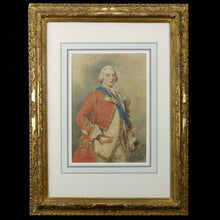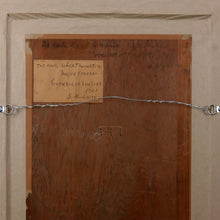Governor of New York - Lieutenant-General The Hon. Robert Monckton (1726-1782), 1890
- Regular price
- £775
- Sale price
- £775
- Regular price
-
- Unit price
- /per
Adding product to your cart
Overall: 55cm (21.6in) x 41.5cm (16in)
Pencil and watercolour on paper. Late Victorian three quarter portrait after Thomas Hudson (1701-1779). Image: 28.5cm x 19.5cm. Framed and glazed.
Lieutenant-General Robert Monckton (1726-1782) is perhaps best known today as the figure in Benjamin’s West’s painting - ‘The Death of General Wolfe’ - holding his hand over the hero’s fatal chest wound. Monckton is also remembered for his role in a number of other important events in the French and Indian War (the North American theatre of the Seven Years' War), notably the capture of Fort Beauséjour in Acadia, and the island of Martinique in the West Indies, as well as for his role in the deportation of the Acadians from British controlled Nova Scotia and also from French-controlled Acadia (present-day New Brunswick). Fort Monckton, Portsmouth is named for him. and is currently an MI6 training facility.
Read more
Robert Monckton was the son of Viscount Galway was commission into the 3rd Foot Guards at the age of 15 and first saw action in the War of the Austrian Succession. In 1752 he was posted to Nova Scotia as commanding officer of Fort Lawrence. The frontier between Nova Scotia and Acadia was calm during this time. Monckton and the French commander of Fort Beauséjour exchanged notes, deserters, and runaway horses during this time, but intelligence was also gathered that would prove valuable to him during subsequent events. On the outbreak of the French and Indian War Monckton was sent to capture Fort Beauséjour which fell after a two week siege. The French commander of Fort Gaspareaux, on the opposite side of the Isthmus of Chignecto, capitulated. Fort Gaspareaux was subsequently renamed Fort Monckton.
Following the capture of Fort Beauséjour, Monckton was made responsible for the deportation of the French aligned Acadian inhabitants of Nova Scotia a task that, Lt. Colonel Monckton executed ‘with characteristic efficiency but no apparent enthusiasm’. Monckton was named Lieutenant Governor of Nova Scotia later in 1755, and in 1758 carried out the final act in the deportation of the Arcadians from Arcadia during the St. John River Campaign
Early in 1759, General James Wolfe chose Monckton to be his second in command for the assault on Quebec. Monckton's role in the siege and later the capture of Quebec was considerable. Monckton established control of the south shore of the St. Lawrence River facing Quebec and was placed in charge of the artillery batteries trained on Quebec from Lévis. Monckton later commanded the 47th Foot on the British right flank during the Battle of Beauport on 31 July.
On 13 September he commanded the dawn landing at Wolfe’s chosen access point of Anse au Foulon, where a narrow path led to the top of the bluff and on to the Plains of Abraham, only a short distance from the walls of Quebec. In the ensuing battle, Monckton again commanded the British right flank and was wounded in the chest. Monckton, although severely wounded assumed command of the defeated city and demonstrated considerable concern for the civilian population. This was a strategically wise decision, as winter was approaching and the occupying British forces needed the goodwill of the civilian population in order to survive the season.
Monckton was reassigned to New York for convalescence, and, in 1762, was given the command of the British expeditionary force against Martinique. The island’s capture was of tremendous strategic importance and proved a valuable bargaining chip in the subsequent peace negotiations. At the Treaty of Paris, which ended the Seven Years' War, the French willingly bargained away Canada and Acadia in return for Martinique. Voltaire at the time, famously stated that Canada was nothing more than "a few acres of snow". Monckton returned from the Caribbean later in 1762. He was subsequently appointed Governor of the Province of New York. He held this position until 1765, even though he left North America for good in 1763 to return to England. Although never legally married, he raised and was survived by three sons and a daughter.








